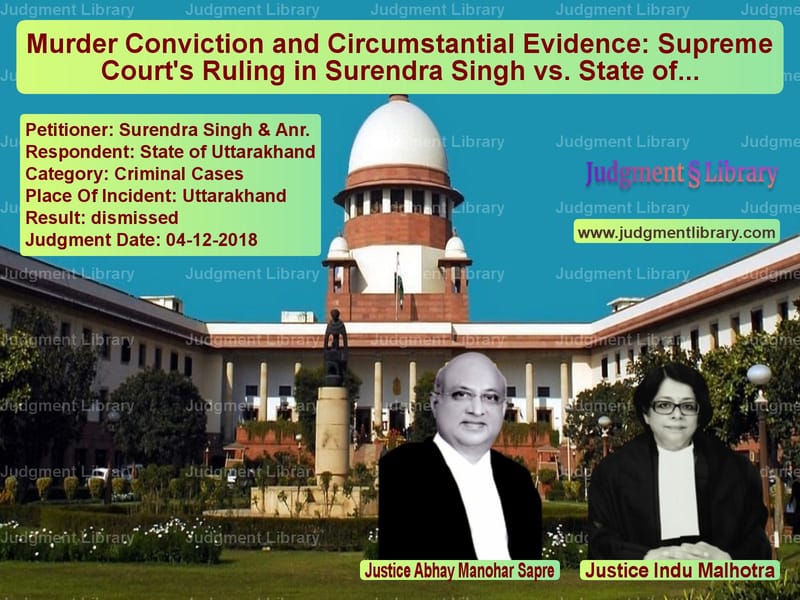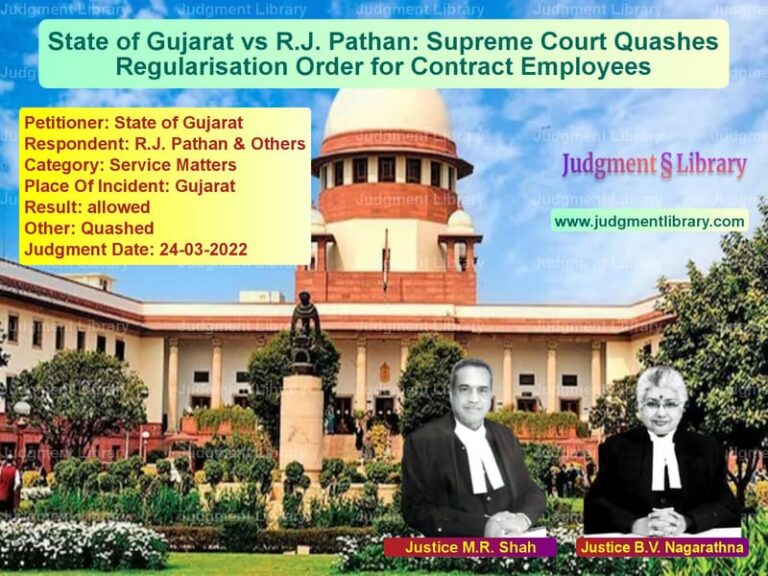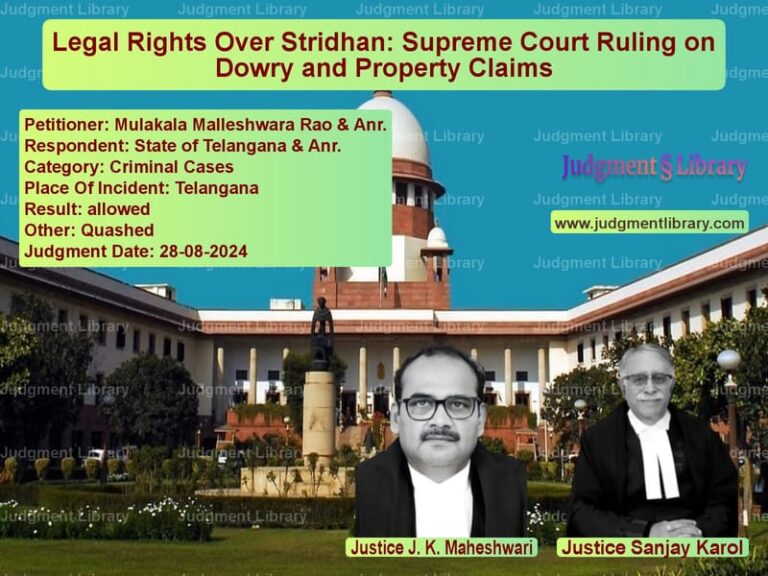Murder Conviction and Circumstantial Evidence: Supreme Court’s Ruling in Surendra Singh vs. State of Uttarakhand
The case of Surendra Singh & Anr. vs. State of Uttarakhand is a critical ruling on circumstantial evidence in criminal trials. This appeal, arising from Criminal Appeal No. 1768 of 2010, was brought before the Supreme Court by Surendra Singh and Ram Singh, challenging their conviction under Sections 457, 380, and 302/34 of the Indian Penal Code (IPC) for the murder of Rajendra Prasad.
The primary issue in this case was whether the prosecution had successfully established the guilt of the accused beyond reasonable doubt, relying entirely on circumstantial evidence. The judgment of the Supreme Court sets a precedent for evaluating the weight of circumstantial evidence in criminal cases.
Background of the Case
The case dates back to January 21, 1990, when the deceased, Rajendra Prasad, was found murdered in his shop in Village Amni, Tehri Garhwal. The following key events led to the prosecution of the accused:
- Rajendra Prasad objected to the presence of Rameshwar Singh (A-1) in the village, as he was allegedly involved in unlawful activities.
- On January 21, 1990, Rajendra Prasad was last seen in his shop.
- The next morning, his shop was found looted, and his body was discovered about 300 meters away from the village water source.
- The post-mortem revealed multiple injuries on his head and body, consistent with a violent assault.
- The police investigation led to the arrest of Rameshwar Singh, Surendra Singh, and Ram Singh.
Trial and Conviction
The Sessions Court found all three accused guilty of murder and robbery, sentencing them to life imprisonment under Section 302/34 IPC, along with additional sentences for house trespass and theft under Sections 457 and 380 IPC. The Uttarakhand High Court upheld the conviction.
Arguments Presented
Petitioner’s Arguments
The appellants contended that there was no direct evidence linking them to the crime. Their key arguments included:
- “The entire case is based on circumstantial evidence, and the prosecution has failed to establish a conclusive chain of events proving our guilt.”
- “There are inconsistencies in witness testimonies, making the evidence unreliable.”
- “The alleged motive for the crime is weak and not supported by sufficient evidence.”
Respondent’s Arguments
The State of Uttarakhand argued that:
- The appellants had a clear motive to kill the deceased, as he had opposed their unlawful activities.
- Their presence near the crime scene was corroborated by multiple witnesses.
- The stolen goods were recovered from the accused, linking them to the crime.
- The injuries sustained by the deceased were consistent with the use of a weapon recovered from the accused.
Supreme Court’s Observations and Judgment
The Supreme Court, comprising Abhay Manohar Sapre and Indu Malhotra, upheld the conviction, stating:
“When the clause is read as a whole, it is clear that the circumstantial evidence forms an unbroken chain leading to the only possible conclusion – that the appellants are guilty.”
The Court highlighted the following key points:
- The appellants were last seen in the vicinity of the crime scene.
- Their involvement was corroborated by multiple witnesses.
- The stolen goods were recovered from their possession.
- The forensic evidence supported the prosecution’s case.
The Court dismissed the appeal, confirming the life sentences imposed by the lower courts.
Legal Significance of the Judgment
This ruling reinforces the principle that circumstantial evidence, when forming a complete chain of events, can be sufficient for conviction in murder cases. The judgment also underscores the importance of motive and corroborative evidence in criminal trials.
Conclusion
The Supreme Court’s decision in this case serves as a benchmark for evaluating circumstantial evidence in murder trials. The ruling affirms that a well-established chain of circumstantial evidence can be as compelling as direct evidence in securing a conviction.
Final Verdict: The appeal was dismissed, and the conviction and life sentences were upheld.
Petitioner Name: Surendra Singh & Anr..Respondent Name: State of Uttarakhand.Judgment By: Justice Abhay Manohar Sapre, Justice Indu Malhotra.Place Of Incident: Uttarakhand.Judgment Date: 04-12-2018.
Don’t miss out on the full details! Download the complete judgment in PDF format below and gain valuable insights instantly!
Download Judgment: Surendra Singh & Anr vs State of Uttarakhand Supreme Court of India Judgment Dated 04-12-2018.pdf
Direct Downlaod Judgment: Direct downlaod this Judgment
See all petitions in Murder Cases
See all petitions in Attempt to Murder Cases
See all petitions in Judgment by Abhay Manohar Sapre
See all petitions in Judgment by Indu Malhotra
See all petitions in dismissed
See all petitions in supreme court of India judgments December 2018
See all petitions in 2018 judgments
See all posts in Criminal Cases Category
See all allowed petitions in Criminal Cases Category
See all Dismissed petitions in Criminal Cases Category
See all partially allowed petitions in Criminal Cases Category







